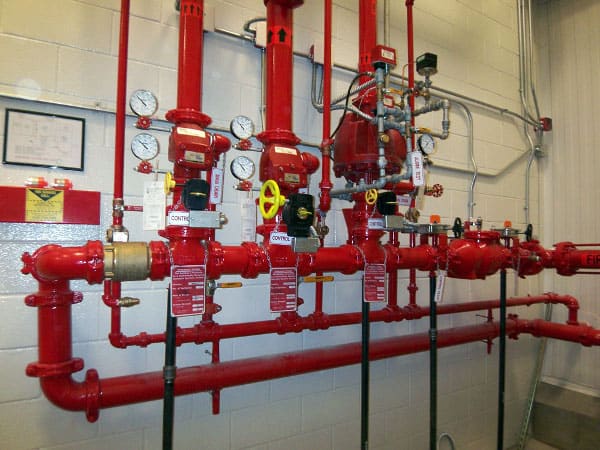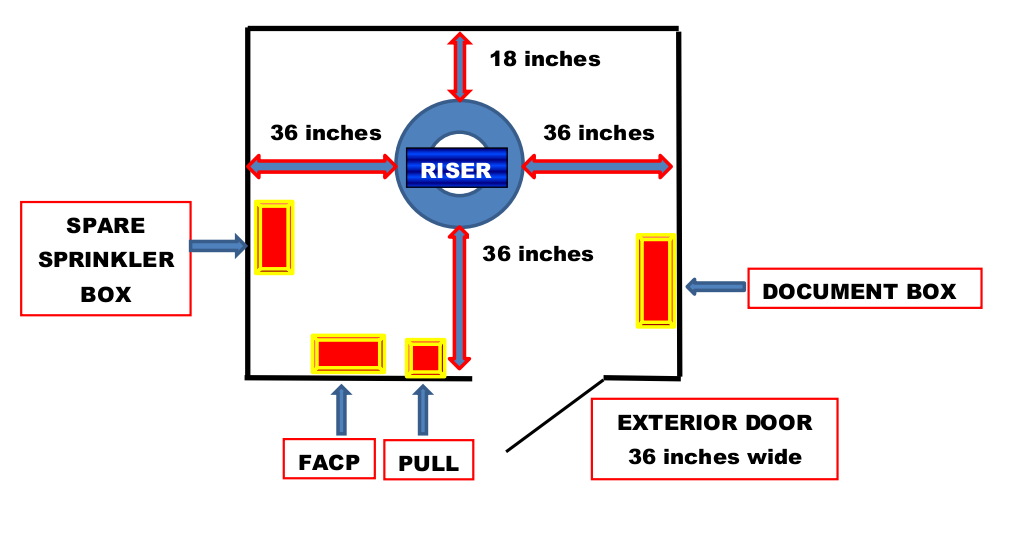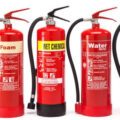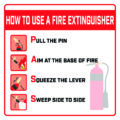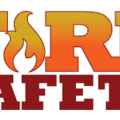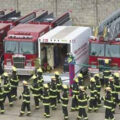What is a Riser Room?
A fire riser room is a room in a building where the fire pump and automatic sprinklers are located. The fire riser room also contains the primary water input for the sprinkler system. Clearly marked Sprinkler Riser Rooms could make a life or death difference in an emergency situation. Fortunately, easy-to-read Sprinkler Riser Room signs identify this critical area for workers and emergency personnel.
There are specific requirements for a fire riser room that are set by the fire department, including that the passageway to the room must be unobstructed. The passageway must also be wide enough that the largest piece of equipment in the room can be removed with ease. Fire riser rooms must have doors, and these doors typically remain locked and closed if the room is not in use.
Do All Fire Sprinkler Systems have Riser Rooms?
The short answer to this question is: No.
Regulators require that a proper riser room be provided for a fire sprinkler system’s risers. A system’s risers may be in a hallway or on the outside of a building. Where the reliance on a fire sprinkler system may not be as strong, a designated room may not be provided or necessary. However, if a riser room is provided, it must comply with mandatory codes and regulations.
What is in the Riser Room?
As stated above, the riser room is essentially the control center for a building’s fire sprinkler system and plays a pivotal role in the overall fire protection of that facility. The riser room provides one, easily identified, and accessible location for all of a facility’s fire sprinkler and fire protection equipment. It will often include most or all of the following:
Sprinkler system risers: the pipes connecting the main water supply and the sprinkler’s cross pipes; if the building is large enough to require multiple sprinkler systems and risers, all should be located in one place. Piping which connects the system’s risers to a fire department connection (FDC), allowing emergency responders to supplement the sprinkler system’s water supply
Primary sprinkler system water input
Sprinkler system valves: valves that function to drain, test, and isolate the system
Backflow prevention devices: devices that ensure water flows one direction into the system, preventing contamination and pollution from flowing back out of the system into the municipal water supply
Pressure gauges: gauges that measure water pressure and/or air pressure (in dry sprinkler systems) to determine if a sprinkler system is in service and has sufficient pressure
Water flow switch: a switch that activates an alarm to alert authorities that the fire sprinkler system has been activated
Water motor gong: a device, usually placed on the outside wall of a riser room, that sounds when water is flowing through the sprinkler system
Tamper switches: switches that signal a warning should the system’s fire protection valves close partially or fully
The fire alarm control panel will sometimes be installed within the riser room
Fire pumps may also be kept within the riser room, though the room will then have to meet the more robust construction requirements for pump rooms as set by regulators.
Fire protection storage cabinet: often, the riser room serves as an ideal location to store spare sprinkler heads, compatible sprinkler wrenches, copies of relevant codes, and inspection logs
Minimum Requirements For a Fire Riser Room
The Fire Equipment Room shall be located within the building footprint. The fire sprinkler riser assembly, the fire alarm control panel, fire alarm manual pull station, spare sprinkler heads storage box, and the document box for “as-built” drawings shall be located within the room. This room shall have an external door, shall be installed inside the building with a door providing access into the fire equipment room. The fire equipment room shall be used for fire protection equipment and controls only.
The minimum size of the equipment room shall allow adequate firefighter access and mobility with the following minimum clearance requirements;
Riser assembly shall have a minimum of 36 inches of clearance around the pipe. One side may be a minimum of 18 inches from a wall.
There shall be 36 inches of clearance in front of the Fire Alarm Control Panel (FACP)
If the roof access ladder is located in the fire equipment room, there shall be 36 inches of clearance in front of the ladder and 24 inches on each side of the ladder.
Detailed and clearly labeled building floor plans, especially for buildings requiring multiples systems, indicating which control valves are responsible for the different floors and sections of the building(s)
It is important to remember that the above is just an example of some of the items that may be found in a riser room.
In general, the following are some of the code requirements that your common riser room will need to comply with:
Sprinkler system risers must be readily accessible within the riser room. The door to the room may be kept locked, but a key must be available at all times to emergency and maintenance personnel. The room should also be kept clear of non-fire-protection-related items that could block access to the risers.
Riser rooms must be situated on the ground floor of the property with an exterior door. The exact location may be determined by the facility owner, but it will often be placed where the water supply enters the building and/or centrally located to ensure the system adequately supplies water throughout the entire facility.
Access doors to the riser room must be clearly marked. The doors must be labeled with approved signage and lettering of a contrasting color to their background.
Riser rooms must be of adequate size to allow maintenance and removal/installation of system parts.
The temperature within the riser room must be kept at 40°F or higher. A permanent heating device must be installed in the room to ensure the appropriate temperature is maintained to prevent freezing pipes and components.
Permanent lighting must be installed.
Ultimately, all codes regulating the design and details of the fire sprinkler system riser room are intended to ensure the protection of the equipment and easy access for both maintenance and emergency personnel.
Properly Designed Riser Rooms Save Lives
A properly designed, easily accessible, clearly marked riser room makes an enormous difference during an emergency and can be what prevents a small fire from becoming a life-altering tragedy.
As previously stated, the regulators’ manual will have further details and additional regulations for your facility’s riser room, and it is of utmost importance that you work with experts to design your riser room. This will not only prevent you from being hit with fines but will also enhance the fire safety preparedness of your facility and those inside.


